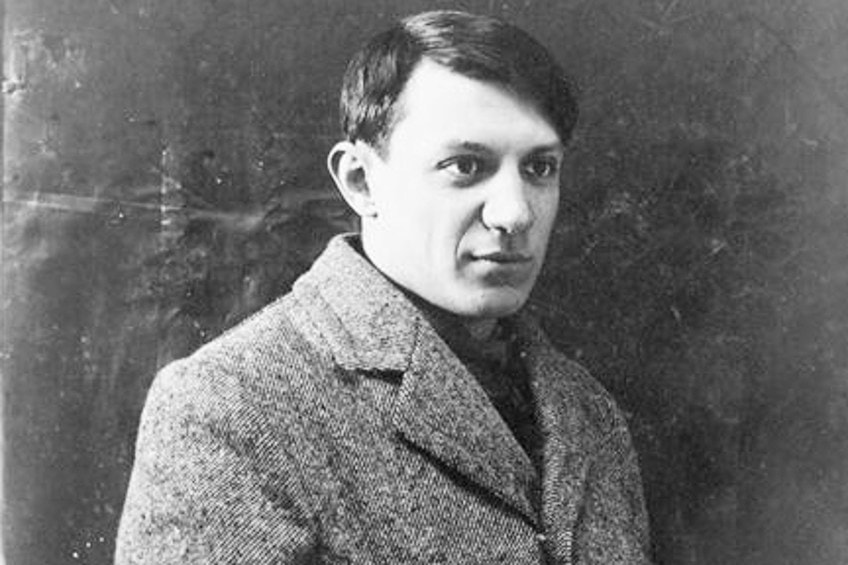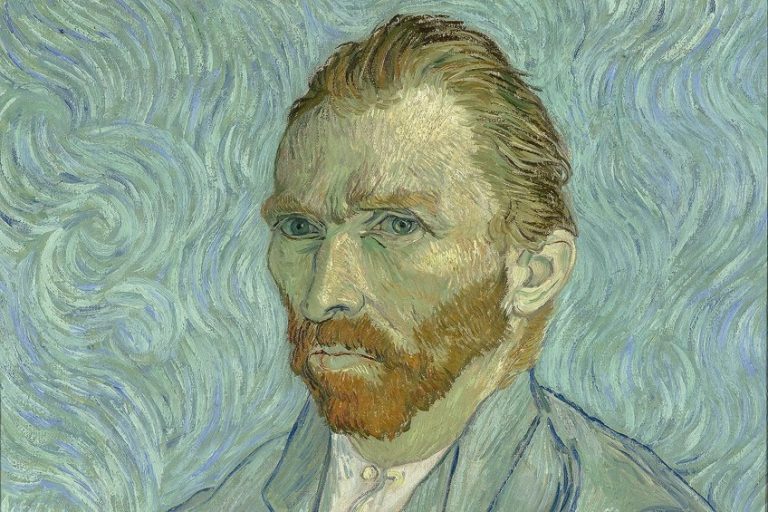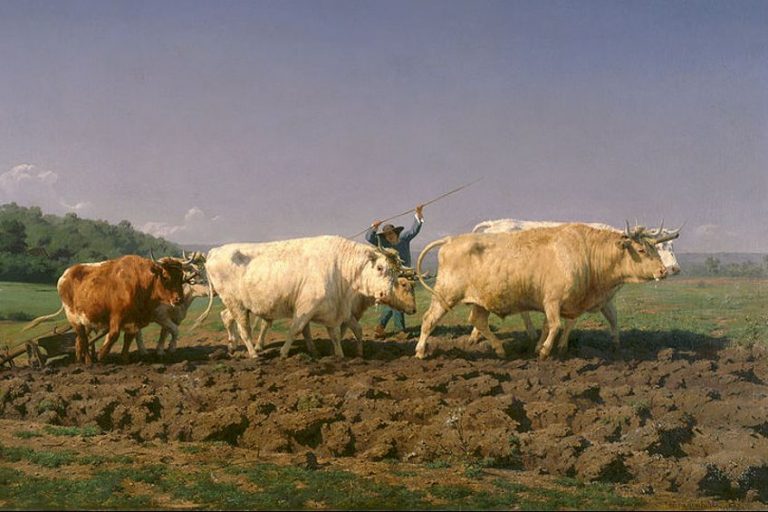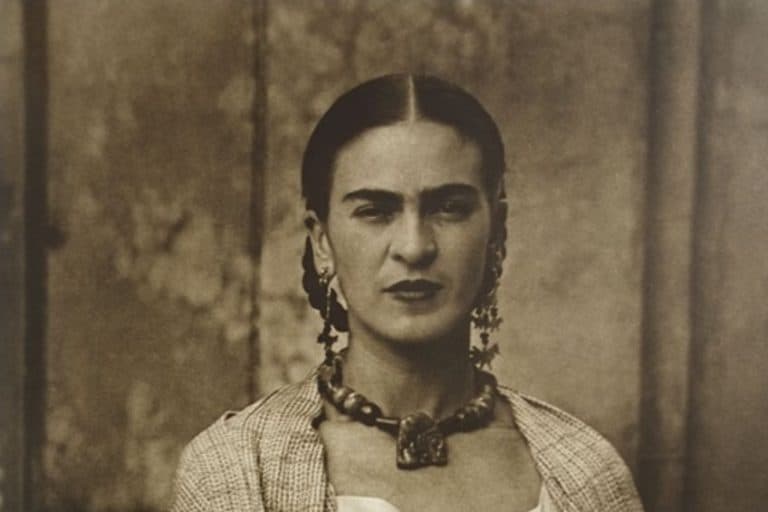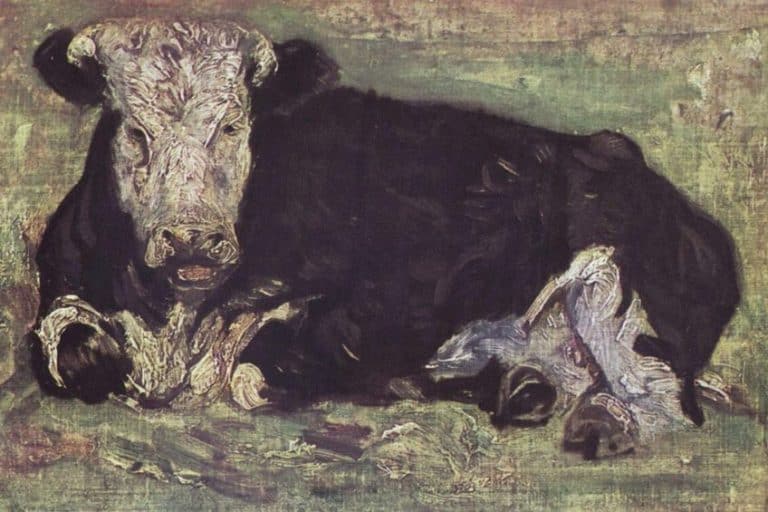“The Old Guitarist” Picasso – Analyzing Picasso’s Guitar Painting
The Old Guitarist (1903) was made towards the end of what has come to be known as Picasso’s Blue Period. The painting itself is not particularly radical but it does mark an important moment in this passionate painter’s path. Contending hundreds of years of refined tradition, the painter endeavored to express and evoke emotion rather than simply illustrate a physical reality. This ambition would become a cornerstone of the Modern Art movement.
The Melancholic Blues of Pablo Picasso’s The Old Guitarist
The painting depicts an old man washed in an unearthly lunar light. Because of his worn clothes, we can surmise that he is destitute. His closed eyes tell us that he might be blind. He appears to be sitting on the floor, legs crossed. His body is slumped, in a lifeless posture, in a dark corner. He is holding and strumming his guitar. The way the body is oriented around his guitar evokes a figure in desperate isolation, finding solace only through his art. The man looks close to death.
| Date of Creation | 1903-1904 |
| Mediums Used | Oil paint on panel |
| Dimensions | 122.9 x 82.6 cm |
| Collection / Location | Art Institute of Chicago |
| Place of Creation | Madrid |
| Associated Art Movement | Expressionism (The Blue Period) |
| Dominant Themes | Poverty, suffering, loneliness, melancholy |
Artist in Context
Picasso may have spent much of his time practicing in Paris, but he was born in the Mediterranean coastal town of Malaga in Spain. From a very young age, he was showing signs of being an exceptional draftsman. With an art teacher for a father, he grew up having his natural talent nurtured. As his father’s surname was Ruiz, he should technically be called Pablo Ruiz but young Pablo had other ideas.
From his earliest sketches, he began practicing signing his mother’s much more glamorous maiden name, Picasso.

Clearly, his confidence was justifiable. The young Picasso demonstrated not only a knack for classical art but a capacity to learn quickly and shift between styles. At 16, he’d already secured a place to study at Madrid’s Royal Academy of San Fernando. There, he studied master painters such as the Spanish court painter Diego Velazquez. However, he must have felt unfulfilled by art school because within a year, he had dropped out.
The Death of Casagemas (1901)
Having left art school Picasso began socializing with fellow creatives which is how he met painter Carles Casagemas. The two formed an instant bond. In 1900, when they were just 19, they set their sights on the artistic opportunities that awaited in Paris. While Picasso had received some interest, he had still not achieved much commercial success.
As Paris was the epicenter of Western art and culture, it was also the center for extravagance and debauchery.
The many paintings produced in their shared Paris depicted scenes of brothels, taverns, hookers, and drunkards. The combination of seedy establishments, absinthe, and unrequited love created a dizzying catastrophe for Casagemas. His heavy drinking did nothing to quell his pining for Germaine, the object of his desires.
On the 17th of February 1901, while Picasso was in Spain, Casagemas invited Germaine and a group of friends to dinner in a Parisian café. Several bottles of wine later, Casagemas got up and mumbled an incoherently slurred speech which no one paid much attention to. But he pulled out a pistol and shot at Germaine. Fortunately, she had the foresight to duck, sustaining just a graze on the neck from the bullet. Casagemas however turned the gun onto his right temple and pulled the trigger.
The 20-year-old Casagemas was dead within the hour and because of the distance, Picasso could not attend his friend’s funeral. Picasso was shattered by the news but his misery would lead to the first major breakthrough of his artistic career.
As he became increasingly consumed with Casagemas’ suicide, he began to commit the memory of his friend to canvas.
Picasso’s first portrayal of his mourning was The Death of Casagemas (1901). The warm, candlelit portrait of his friend Casagemas shows only the bullet-marked lifeless head, perched from within a coffin. Picasso would produce another rendition of the painting that same year, Casagemas in His Coffin (1901) depicting again the corpse in a casket, except this time no candlelight. The painting is much darker than the original and the tones eerily blue.
The Blue Period
Picasso began painting his blue pictures somewhere between late spring of 1901 and the following January. Only a year after the two best friends had come to Paris, Picasso was painting cathartic pictures of his friend in a coffin. This experience triggered a transition in Picasso’s artistic development that was so significant it came to be known as the Blue Period.
The use of blues, blacks, greens, and browns to create a sense of melancholy, loneliness, despair was a key characteristic of the Blue Period.
Initially, the subject matter seemed to revolve around the theme of death, but as the body of work developed, Picasso became interested in people at the bottom of society, with flaws, defects, and woes. He painted the poor, often half-naked beggars, often with some sort of physical defect.
While the Blue Period, like many other phases of his career, would feature more female subjects than men, the men seem to be in more distress. Many of the figures in his Blue Period have slender, elongated, angular physiques and stretched fingers.
This was an incredibly productive period for Picasso, whose complex ways of working availed him to a myriad of styles through which he could navigate at will.
While he had not yet reached the height of his career when this work was made, he was demonstrating exceptional visual literacy. Arguably the most popular painting of Picasso’s Blue Period made towards its end is The Old Guitarist. The Blue Period lasted from 1901 to 1904 and this painting was made in 1903, when the artist was in his early twenties.
Taking a Closer Look at the Artwork
The Old Guitarist is one of the most well-known images that came out of the Blue Period. As iconic as it is, some of the finer details of this artwork can often be missed. In spite of its touching simplicity, this painting is layered with immense meaning and skill.
Color
In the primarily monochromatic painting The Old Guitarist, Picasso harmonized the variations between tonal values. Clearer tones cover the higher part of the painting, while deep, dark tones define the low end. The artist’s decisions on where to use various greens, blues, grays, and blacks are crucial in orchestrating the feeling of melancholy.
While blues, blacks, and greens are the obvious colors of this scheme, there is a rupture in the very heart of the image with the brown of the guitar. The brown guitar creates tension with the blue, dominant in the rest of the painting. Picasso had employed a similar tactic in other works of the Blue Period. Because of the coloring of the brown guitar, the object signifies not only the subject’s sustenance but their symbol of hope.
Part of the genius of Picasso is that he can be subtle. The quietness of these insightful infusions is what makes them effective. Even in the darkest moment, Picasso is saying, there will be light at the end of the tunnel.
Form
The Expressionist movement’s exploration of emotion is what set it apart in its time. While it was a necessary rite of passage for the young painter, he outperforms the genre by boasting a great deal of logic in the construction of this evocative painting. Effortlessly, the painting demonstrates the artist’s depth of education and knowledge.
Unlike in the high frequency of some of his later works, in The Old Guitarist Picasso is much more subdued. The simple alignment of the elements is what gives this painting its slow sense of movement. The old man’s feet create a big curve at the bottom of the canvas, the shoulder and guitar complement the curve, endorsing an evocation of a strumming motion.
The scarcity of pattern and repetition makes it more static and claustrophobic which is a good thing considering what the painting is trying to convey.
Depth is created through a contrast in shapes. The basic rectangular shapes represent the foreground and background. They are either light on a dark background or dark on a light background. There are four rectangular planes. They all represent the ground in the foreground, the pavement in the second plane, then a low wall and sky in the background.
The space that recedes in front of and behind the old man looks limited. There is a sense that the figure is close up as the image is cropped tightly and somewhat frontal. The guitarist’s head is the focal point on the top left-hand side of the canvas. The old man’s torso is angular which is somehow accentuated by the grim lines under his face.
While the shape of the guitar is curvy, the points between the guitar, the performer’s head, and his hands create a triangle.
The painting is delineated by diagonal lines with the neck of the guitar forming the main upward diagonal. Because of this diagonal, the guitar falls on two natural points of interest, engaging the rule of thirds. It is also practically positioned at the center of the painting, which amplifies its focus.
The old man’s misery is amplified by the formal decisions made by the artist. Because of the pictorial boundaries that encase him, the guitarist’s relief from his cramped posture seems spatially impossible. His captive condition prevents him from stretching his legs or lifting his head, which compounds his grief.
Aesthetics
The Picasso guitar painting blends many of the devices he had used in the Blue Period. However, many of these devices are part of a long painting tradition that stretched behind and before him. This painting and other images in this body of work are iconic simply for their blue-dark tones.
However, this palette of cold and melancholic colors, often offset by some warm brown element, is rooted in Picasso’s deep knowledge and appreciation of western painting traditions.
The French palette was rooted in discoveries of new pigments like Prussian blue and cobalt in the 1700s, and the subsequent development of French ultramarine in the early 1800s. The brown palette was of course influenced by Dutch painters like Rembrandt van Rijn.
So indebted was Spanish painting to Dutch masters that the term “Hispano-Flemish” was often used to describe the hybrid styles of painters such as José Moreno Carbonero who influenced Picasso. Picasso was attempting to build a bridge between the two great traditions by looking at French painting traditions through a Spanish lens.
In many Blue Period paintings, the guitarist’s torso is elongated. The downward inclination of his poor neck is not only physically impossible but also extremely expressive. The distortion of the human body in order to achieve a particular purpose is a common feature of global art history.
Picasso looked to the mannerist El Greco, who became known during the Spanish renaissance for painting abnormally tall, elongated figures in order to heighten their spiritual prowess.
While his peers were turning their backs on classical painting traditions, Picasso was determined to bring these old traditions into the modern age. He was only twenty years old and yet already bold enough to compare himself to the masters. In The Old Guitarist Picasso was using the symbolist foundations of Spanish traditions in conjunction with the modernist pace of French styles to position his work as a direct descendant.
As Paris was the art capital of the western world in the 1900s, Picasso identified it as a place where he needed to be. As such, he would absorb in typical Picasso fashion the traditions of French painting and regurgitate them in his work. Like many artists, he quoted the artists he admired. For him, these included Jean-Auguste-Dominique Ingres, Paul Gauguin, Auguste René Rodin, Henri de Toulouse-Lautrec and Edgar Degas. These were the French artists who had made the biggest impact on Picasso in 1901 when he made The Old Guitarist.
However, this Picasso guitar painting was made in Madrid and it shows. When you look at the various works in the Blue Period, which were made between Paris, Barcelona, and Madrid, it becomes clear that whenever he returned to Spain, he was also returning to Spanish art. While a work like The Blue Room (1901) is clearly quite French in its style and subject matter, The Old Guitarist seems to emphasize Picasso’s Spanish roots.
The fact that Picasso was being influenced by great Spanish masters and Spanish realism is particularly important because of the adulation of the poor in the iconography of golden age Spanish painting.
The classical period used the allegorical virtue of charity as a common trope. In paintings like The Old Guitarist, Picasso was attempting to reinvent old Spanish masters’ realist interpretations of the plight of the poor. Of course, this complicates commonly held concepts of Picasso’s empathy for the proletariat. Following the age-old tradition of asserting to ennoble the poor through grand artistic gestures may elevate the image of these people into virtuous figures, but it could perversely exploit their suffering for the enjoyment of the elite.
While this consideration does raise questions about how Picasso is playing into this long history painting, the painting has nevertheless managed to hold its own head and shoulders above the masters that may have inspired it.
Picasso combines the simplification of compositional devices with classical traditions in order to create an entirely new lineage of image.
Meaning
But this painting is more than just another picture of the poor. Much of the critique about the tradition of European painters painting the poor dissipates in the face of the fact that Picasso had himself been having financial troubles when he made The Old Guitarist. The young artist Picasso was at a point in his career where he had no real patrons or collectors in France or Spain. He was prolific and was recognized but he had not yet found favor.
During this time, he was so poor that he had to burn many of his paintings just to keep the room warm. Often, he painted over paintings because he couldn’t afford to buy new canvases. It’s for this reason that this period saw him produce so many drawings. For this reason, it is not difficult to imagine The Old Guitarist as an allegory of the artist’s own strife.
Because of his own brush with poverty, Picasso could relate to those suffering a similar fate.
The bony old man cradles his guitar in a way that makes it seem sacred. Clearly, the man depends on it as a means of survival. The old man is literally and figuratively leaning on the guitar. It is his only hope. In the painting, the old man seems so enthralled by the sound of his guitar that he may momentarily forget about his pain and hunger.
It isn’t just the capable command of form that makes this painting iconic, but its ability to harmonize that with the subject matter. Because there are two main points of interest in the painting, that is the head and the guitar, the viewer can easily consider the subject as both the guitarist and the guitar.
The guitar takes up a large symbolic space as well as physical in the artwork.
While it would make sense to imagine it emitting a sad sound, the guitar carries an ambiguous sense of sadness. The old man seems to have next to nothing. Not even untorn clothes or a seat to sit on. The viewer is given enough information to understand the depths that he has sunk to. But he still has his guitar and in the case of this painting, that could mean he still has hope.
Because of its universality, this hope is the most profound connection between the viewer, the artist, and the artwork. The hope The Old Guitarist evokes is itself a thing of beauty. Laboring over this painting, the artist demonstrated his own sense of hope in a moment of darkness. Essentially both men are artists and even in their isolation, they expose themselves to us the viewer imploring us to see their art, empathize and help them.
Details
The old man is extremely thin and has abnormally long fingers. His body seems to have been stretched and deformed by suffering and hunger. His clothes are tattered and torn exposing his shoulder and other parts of the body. Closer inspection discerns that the bones on his legs are standing out. Looking at the painting from another angle, it is clearer to see that the old man’s eyes are closed and his mouth is open. These features, particularly in The Old Guitarist connote a languid expression of suffering.
Because of the layered way in which the artist has treated the structure of this painting, it is possible that there are some things that have gone undetected.
This may pertain to aspects of the painting which are difficult to rationalize or appreciate like the foot on the bottom left-hand side of the painting which is awkwardly positioned so it falls right off the edge of the painting.
Examining Picasso’s engagement with lightness and darkness in this image produces further illuminations.
The light source of this painting seems to be emanating from the gloomy moon and his key features are contoured by the lunar light. The signature sits on the other end of the spectrum. Its dark value is enmeshed on a dark background that appears vivid enough to be seen without competing with the image.
Underpainting
Researchers revealed that there were two to three sketches or unfinished paintings underneath The Old Guitarist, after conducting an x-ray of it. The paintings underneath were eventually deciphered in 2001 by researchers from the Art Institute of Chicago. The most perceivable of these underpaintings is an image of a seated woman with her head facing left. But the infrared technology showed another image of a young woman’s face and neck looking to the right. There is also perceivably the feet, torso, and profile of a child at one of these women’s feet.
The fact that Picasso even had to paint over some of his old paintings is proof that the artist was penniless.
He was so poor that could barely afford food let alone new art materials and canvases. Some have suggested that part of the power of this painting is that it is painted over other paintings. The layered ghostly images visible from underneath The Old Guitarist could be said to have been happy accidents that nudged Picasso in the direction of cubism.
Light at the End of the Tunnel
An overwhelming amount of public attention has been focused on Picasso’s more mature work from the 20s, 30s, and 40s. But this artist had a long and winding road before he became the megastar that has come to be associated with his prolific career. The Blue Period was one of the least lucrative collections of Picasso’s career.
Yet, even when no one was buying his art, he persisted because he believed in his artistic vision and vitality. When Picasso was in that deep dark place, painting became his source of hope and encouragement.
The painting in question has a deceptive simplicity to it. Perhaps that is precisely why it is so convincing. It represents deeply subjective human experiences in keeping with the modernist movement of expressionism which dated from 1905 to 1920, for which The Old Guitarist is said to have been a precedent. Expressionism was founded on modern artists prioritizing the expression of emotional experiences rather than perceivable physical realities.
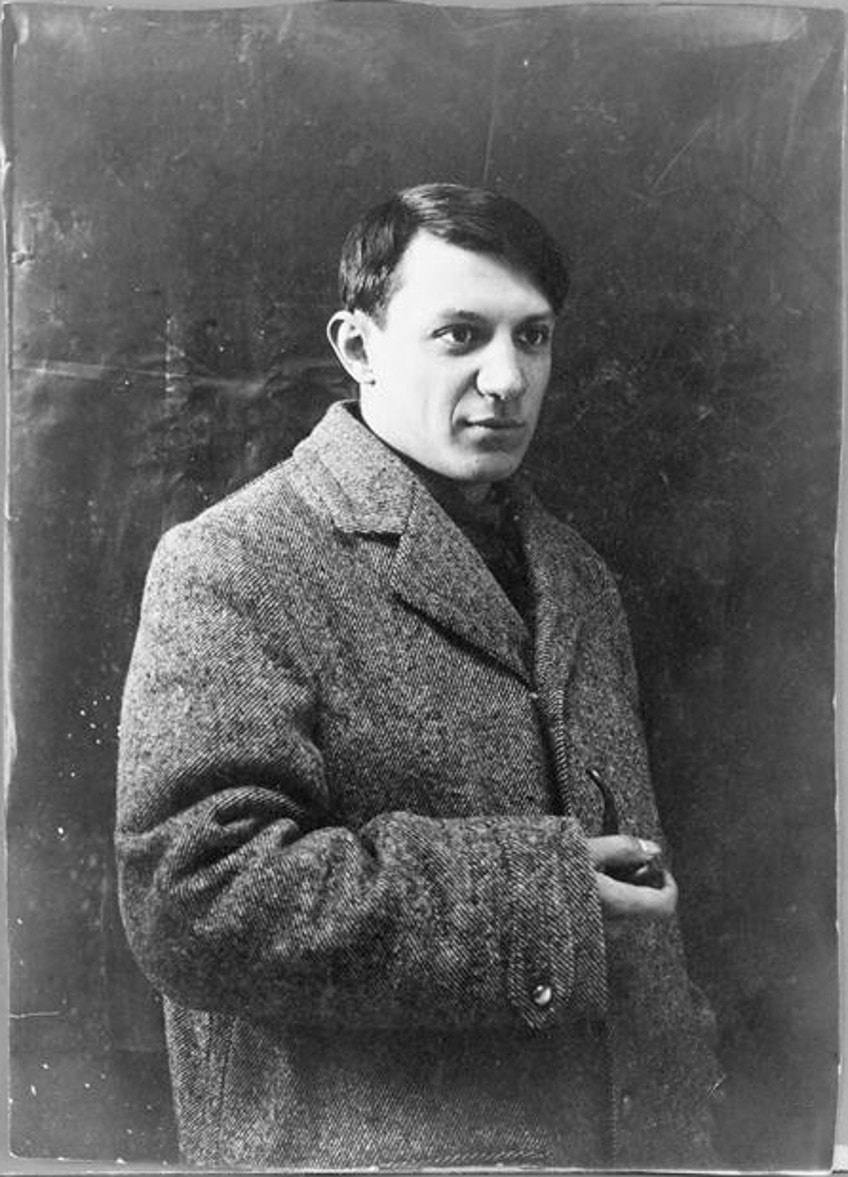
From our perspective in the 21st century, it’s not a stretch to see The Old Guitarist as a beautiful image. But for those who were privy to this painting when it was new, from 1903 to 1904, it might have appeared unconvincing partly because of the artist’s deformation of the human body. Picasso was certainly not the first artist in the 19th century to do that, but his contribution to these painting traditions would change the very concept of what we call beautiful.
The Old Guitarist is a window into Picasso’s experience with grief and poverty at a watershed moment right before he became the most famous artist alive. His ability to draw from art history as well as real-life would catapult him into superstardom. Whether the artist was using his head, his heart, or both when he began producing images that elicited empathy for the poor is indeed a debate for the ages.
These unanswerable questions are what gives the image its relatable longevity. The themes of poverty, loss, and sadness are as relevant in contemporary life as they were in Picasso’s day. His efforts to make visible those marginalized by society do denote the compassion he felt for the downtrodden. He didn’t just paint the poor as they appeared, he experimented with various ways of depicting their inner dimensions. Somehow, he built a new bridge between the melancholic and the sublime. This work led him towards the more colorful and radical works that have become a symbol of his success. This trajectory is proof that there is indeed light at the end of the tunnel.
Take a look at our The Old Guitarist webstory here!
Frequently Asked Questions
What Was the Purpose of The Old Guitarist?
The painting was both a metaphor for the human condition and an advocate for marginalized people. It was also a technical exercise and attempted to use form to express feelings of grief and sorrow.
What Would The Old Guitarist Be Worth Today?
It’s unlikely that The Old Guitarist will go back on the market anytime soon, but experts estimate that this iconic artwork’s value exceeds the $100,000,000 mark.
Is The Old Guitarist Picasso Cubism?
No. This work was made during an earlier phase in Picasso’s career known as the Blue Period. He would later transform his styles through the Blue Period (1901-1904), the Rose Period (1905-1907), the African-influenced Period (1908-1909), and Picasso Cubism (1909-1919).
Heidi Sincuba was the Head of Painting at Rhodes University from 2017 to 2020 and part of the first Artist Run Practice and Theory course at Konstfack in Stockholm, 2021. They completed their BFA at Artez Arnhem in the Netherlands, MFA at Goldsmiths University of London, and are currently a Ph.D. candidate at the University of Cape Town.
Heidi Sincuba’s own practice explores fugitivity through painting, drawing, text, textiles, performance, and installation. This praxis is founded on a conceptual intersection of biomythographic experimentation, existential automatism, and African ancestral knowledge systems. These methodologies of multiplicity result in a fluid and speculative aesthetic, continually manifesting and metamorphosing its material conditions.
Learn more about the Art in Context Team.
Cite this Article
Thembeka Heidi, Sincuba, ““The Old Guitarist” Picasso – Analyzing Picasso’s Guitar Painting.” Art in Context. March 18, 2022. URL: https://artincontext.org/the-old-guitarist-picasso/
Sincuba, T. (2022, 18 March). “The Old Guitarist” Picasso – Analyzing Picasso’s Guitar Painting. Art in Context. https://artincontext.org/the-old-guitarist-picasso/
Sincuba, Thembeka Heidi. ““The Old Guitarist” Picasso – Analyzing Picasso’s Guitar Painting.” Art in Context, March 18, 2022. https://artincontext.org/the-old-guitarist-picasso/.


